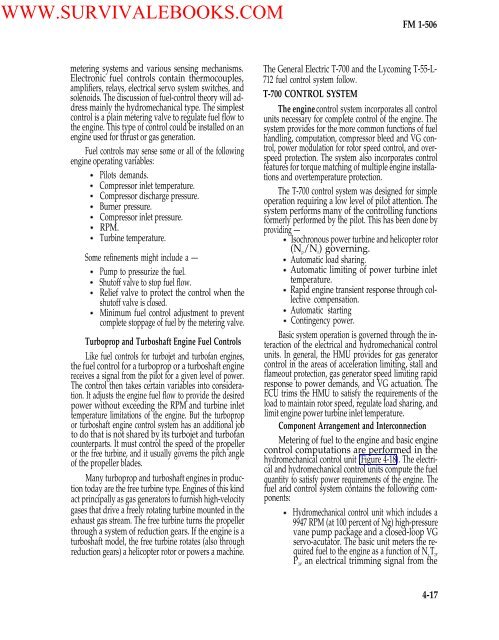FM 1-506 Fundamentals of Aircraft Power Plants ... - Survival Books
FM 1-506 Fundamentals of Aircraft Power Plants ... - Survival Books
FM 1-506 Fundamentals of Aircraft Power Plants ... - Survival Books
Create successful ePaper yourself
Turn your PDF publications into a flip-book with our unique Google optimized e-Paper software.
WWW.SURVIVALEBOOKS.COM<strong>FM</strong> 1-<strong>506</strong>metering systems and various sensing mechanisms.Electronic fuel controls contain thermocouples,amplifiers, relays, electrical servo system switches, andsolenoids. The discussion <strong>of</strong> fuel-control theory will addressmainly the hydromechanical type. The simplestcontrol is a plain metering valve to regulate fuel flow tothe engine. This type <strong>of</strong> control could be installed on anengine used for thrust or gas generation.Fuel controls may sense some or all <strong>of</strong> the followingengine operating variables:Pilots demands.Compressor inlet temperature.Compressor discharge pressure.Burner pressure.Compressor inlet pressure.RPM.Turbine temperature.Some refinements might include a —Pump to pressurize the fuel.Shut<strong>of</strong>f valve to stop fuel flow.Relief valve to protect the control when theshut<strong>of</strong>f valve is closed.Minimum fuel control adjustment to preventcomplete stoppage <strong>of</strong> fuel by the metering valve.Turboprop and Turboshaft Engine Fuel ControlsLike fuel controls for turbojet and turb<strong>of</strong>an engines,the fuel control for a turboprop or a turboshaft enginereceives a signal from the pilot for a given level <strong>of</strong> power.The control then takes certain variables into consideration.It adjusts the engine fuel flow to provide the desiredpower without exceeding the RPM and turbine inlettemperature limitations <strong>of</strong> the engine. But the turbopropor turboshaft engine control system has an additional jobto do that is not shared by its turbojet and turb<strong>of</strong>ancounterparts. It must control the speed <strong>of</strong> the propelleror the free turbine, and it usually governs the pitch angle<strong>of</strong> the propeller blades.Many turboprop and turboshaft engines in productiontoday are the free turbine type. Engines <strong>of</strong> this kindact principally as gas generators to furnish high-velocitygases that drive a freely rotating turbine mounted in theexhaust gas stream. The free turbine turns the propellerthrough a system <strong>of</strong> reduction gears. If the engine is aturboshaft model, the free turbine rotates (also throughreduction gears) a helicopter rotor or powers a machine.The General Electric T-700 and the Lycoming T-55-L712 fuel control system follow.T-700 CONTROL SYSTEMThe engine control system incorporates all controlunits necessary for complete control <strong>of</strong> the engine. Thesystem provides for the more common functions <strong>of</strong> fuelhandling, computation, compressor bleed and VG control,power modulation for rotor speed control, and overspeedprotection. The system also incorporates controlfeatures for torque matching <strong>of</strong> multiple engine installationsand overtemperature protection.The T-700 control system was designed for simpleoperation requiring a low level <strong>of</strong> pilot attention. Thesystem performs many <strong>of</strong> the controlling functionsformerly performed by the pilot. This has been done byproviding —Isochronous power turbine and helicopter rotor(N p/N r) governing.Automatic load sharing.Automatic limiting <strong>of</strong> power turbine inlettemperature.Rapid engine transient response through collectivecompensation.Automatic startingContingency power.Basic system operation is governed through the interaction<strong>of</strong> the electrical and hydromechanical controlunits. In general, the HMU provides for gas generatorcontrol in the areas <strong>of</strong> acceleration limiting, stall andflameout protection, gas generator speed limiting rapidresponse to power demands, and VG actuation. TheECU trims the HMU to satisfy the requirements <strong>of</strong> theload to maintain rotor speed, regulate load sharing, andlimit engine power turbine inlet temperature.Component Arrangement and InterconnectionMetering <strong>of</strong> fuel to the engine and basic enginecontrol computations are performed in thehydromechanical control unit (Figure 4-18). The electricaland hydromechanical control units compute the fuelquantity to satisfy power requirements <strong>of</strong> the engine. Thefuel and control system contains the following components:Hydromechanical control unit which includes a9947 RPM (at 100 percent <strong>of</strong> Ng) high-pressurevane pump package and a closed-loop VGservo-acutator. The basic unit meters the requiredfuel to the engine as a function <strong>of</strong> N gT 2,P 3, an electrical trimming signal from the4-17
















